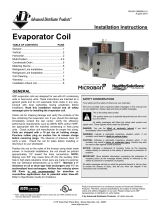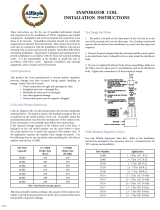
A-COIL
A-Coils are designed for upflow/downflow applications. Vertical drain pans have drain connections on the right and left front
side of the evaporator coil. Airflow face velocity above 350 ft/min is not recommended for down-flow applications due to
potential water blow-off. Refer to Specification Guide for limitations. In down-flow applications, aluminum foil tape must be
applied to seal the top edge of the insulation to the cabinet. This tape will prevent the possibility of the insulation delaminating
and blocking airflow.
MULTI-POSITION A-COIL
Multi-position coils come factory installed with a vertical and horizontal drain pan, which can be configured for up-flow, down-
flow, horizontal blow-through or horizontal pull-through installations. In the center opening of vertical drain pan, a metal Inlet Air
Restrictor is factory installed and is required for horizontal applications. It may be removed for vertical applications. Airflow face
velocity above 350 ft/min is not recommended for downflow or counterflow applications due to potential water blow-off. Refer to
Specification Guide for limitations. For horizontal configurations, install splashguard (included) onto the coil outlet, and extend
suction line insulation into the coil cabinet by 2” to prevent moisture from dripping onto the insulation (the rubber grommet may
need to be removed). Splashguard installation is not required for vertical configurations. Bottom flange of guard should rest on
pan and sides screwed to the duct flanges. See page 5, Figures 4 & 5 for splashguard instructions.
In down-flow and pull-through configurations aluminum foil tape must be applied to seal the top edge of the insulation to the
cabinet. This tape will prevent the possibility of the insulation delaminating and blocking airflow. In horizontal pull-through
configurations, a minimum 12” transition is required in front of the coil as shown in the figure below. This is required to ensure
proper airflow distribution and to reduce pressure drop. Coils that are 20” or less in height and are installed in a cabinet with a
height of 25-½“ or greater do not require a transition; all other coil models require this transition. Coil should be level, or pitched
slightly toward the drain connection. It is recommended to add silicone caulk between drain pans to prevent water carryover.
Note: Multi-position Coils are also field convertible from left-to-right or right-to-left; see page 6 for instructions on field
conversion for horizontal airflow.
Pre system startup checklist for Multi-Position coils – Refer to Figure 3
• Is splash guard installed? (Figure 3 Configurations A and B)
• Airflow adjusted to rated CFM?
• Is 12” transition installed as shown below? (non-standard horizontal applications)
• Factory installed Inlet Air Restrictor present in the center opening of the drain pan (horizontal applications)?
• Factory installed internal water diverter in place? Refer to Multi-Position A-Coil Field Conversion on page 6.
• Unit slightly tilted toward drain connection used?
• Drain line connected and trapped per these instructions?
Splash-
guard
FURNACE
12” min
12” min
A. Standard Horizontal Application
Left hand shown
Right hand similar (not shown)
LOWEST STATIC CONFIGURATION
See Spec Guide for additional data
Right hand shown
Left hand similar (not shown)
Left hand shown
Right hand similar (not shown)
Left hand shown
Right hand similar (not shown)
12” min
edge of insulation










